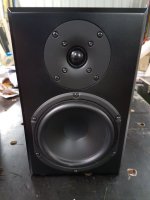Well it's been a while since I've built my last set of speakers and almost as long since I've built any for a customer too. I recently came across some spare tweeters from my surround sound build (spousal approval could only be had for a 5.1 system, 7.2 got a big no). Seeing as I had these plus some random crossover components I decided to get some woofers and the rest of the parts and get building a set of bookshelf speakers.
This build was a series of firsts for me using a few techniques I've never done before. Usually I use pre veneered mdf for my builds. This time I used plain mdf and veneered it myself (never done my own veneer without an industrial vacuum bag press) as I'd recently been given some nice Jarrah veneer.
I went with a sprayed satin black front baffle which I'd never done before either, 1 because I didn't have enough veneer to do all 6 sides of the box and 2 wifey wasn't keen on the cost of me doing the fronts in carbon fibre (regardless of the fact they'd then be the coolest speakers ever!).
Next on the never been done before list was the finish. I usually spray poly or 2k clear but this time went for French Polish. I've always wanted to try it out but never had a need for it so I thought this was the go. They got 12 coats then a rub back with 1200 paper then some wax to knock back the gloss a bit. Please ignore the blob of wax in the grain in one of the pics. I only just noticed that myself looking at the pic, the flash picked up what I couldn't see in the shed so I'll re buff that side tomorrow.
Now the woodwork side of it is out of the way I'll ramble on about the electrics as there are a few speaker buffs here. The woofers and tweeters are Peerless. The box is rear ported with an internal volume of 7.7L, a sheet of dampening material was applied to the inner back wall of the box too. For the eagle eyes out there, yes the tweeter is deliberately connected out of phase.
I've only just begun the break in process and have already been impressed with their ability with rock and blues so all in all quite happy with the finished result.
This build was a series of firsts for me using a few techniques I've never done before. Usually I use pre veneered mdf for my builds. This time I used plain mdf and veneered it myself (never done my own veneer without an industrial vacuum bag press) as I'd recently been given some nice Jarrah veneer.
I went with a sprayed satin black front baffle which I'd never done before either, 1 because I didn't have enough veneer to do all 6 sides of the box and 2 wifey wasn't keen on the cost of me doing the fronts in carbon fibre (regardless of the fact they'd then be the coolest speakers ever!).
Next on the never been done before list was the finish. I usually spray poly or 2k clear but this time went for French Polish. I've always wanted to try it out but never had a need for it so I thought this was the go. They got 12 coats then a rub back with 1200 paper then some wax to knock back the gloss a bit. Please ignore the blob of wax in the grain in one of the pics. I only just noticed that myself looking at the pic, the flash picked up what I couldn't see in the shed so I'll re buff that side tomorrow.
Now the woodwork side of it is out of the way I'll ramble on about the electrics as there are a few speaker buffs here. The woofers and tweeters are Peerless. The box is rear ported with an internal volume of 7.7L, a sheet of dampening material was applied to the inner back wall of the box too. For the eagle eyes out there, yes the tweeter is deliberately connected out of phase.
I've only just begun the break in process and have already been impressed with their ability with rock and blues so all in all quite happy with the finished result.





